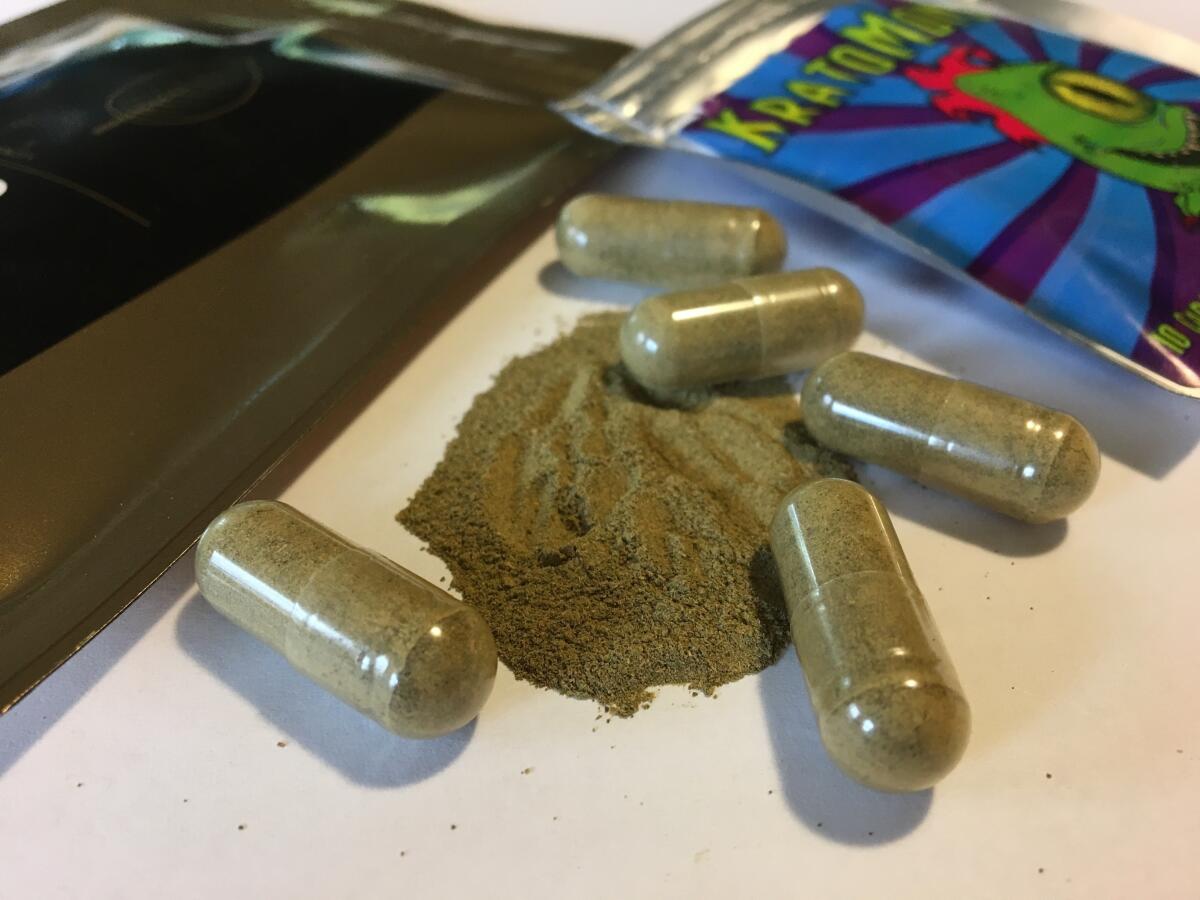Kratom products have gone unregulated in California, unnerving both fans and critics

It comes in greenish powders, capsules and extracts, and is readily found in smoke shops and online.
Some say they use it for an energy boost or as a mood lifter. Others seek relief from pain. It can act both as a stimulant and as a sedative. Doctors have warned that in some cases, it has led to seizures or vomiting, and the Drug Enforcement Administration categorizes it among its “drugs of concern.”
Yet “kratom is not regulated at all in California,” said Assemblymember Matt Haney (D-San Francisco). Right now, there are “not even labeling requirements or age restrictions.”
Kratom products are derived from the leaves of the Mitragyna speciosa tree in Southeast Asia, where the plant has long been chewed and brewed in teas. Its complex effects have been tied to mitragynine and other alkaloids — chemical compounds containing nitrogen — that act on systems in the brain and body.
The Food and Drug Administration has warned against using kratom for medical treatment, stressing that it has not approved any medications containing kratom and that it cannot be legally marketed in the U.S. as a dietary supplement.
Ozempic and other drugs raised the possibility of reversing the country’s obesity crisis. Doctors are frustrated that they’ve made health disparities worse.
Yet roughly 2 million people in the U.S. use kratom, according to estimates from a federal survey, and some researchers and advocates say usage is actually much higher. Among those who have turned to the herbal substance is Dijon Evans, a 61-year-old living in Sacramento, who has a medical condition that racks her with pain.
“My body feels like I’m being electrocuted from the inside out. I get these sharp electrical jolts that shoot through my body and my limbs,” Evans said. At one point, she started planning to end her life.
“I hate admitting that, but that’s the point I was at,” she said.
Someone on Facebook suggested kratom. Evans said she read up on it, talked to her doctors and family, and decided to order some kratom powder. It arrived in the mail. She downed half a teaspoon in orange juice.
The pain fell to a tolerable level, she said. “I was dumbfounded,” said Evans, who had been skeptical of herbal supplements. “Here’s something that I held no hope in helping me — and it quite literally saved my life.”
The Drug Enforcement Administration backed off on plans eight years ago to designate kratom as a “Schedule I” drug, a restrictive category for drugs without any accepted medical use, after pushback from kratom advocates and lawmakers.
But a patchwork of state and local laws has sprung up amid concerns about the array of kratom products found in stores and online, which researchers warn could have starkly different effects. In California, where kratom has become a common fixture in vape and smoke shops, lawmakers are now aiming to reel in an unregulated market.
Under Assembly Bill 2365, the measure proposed this year by Haney, the state would require kratom products to be registered with the public health department. It would also regulate their chemical content, mandate labeling with alkaloid amounts and warnings that kratom may be habit forming, and bar kratom sales to anyone under age 21.
“There are enough risks that it shouldn’t be a total free-for-all,” Haney said. “People should know what they’re buying. Kids shouldn’t buy it. And we should make it clear that there’s a difference between a bottle that may seem the same size — but may have exponentially more potency.”
The proposed rules also prohibit kratom products from containing synthesized forms of kratom chemicals that have troubled some researchers and advocates, who warn that such products could veer far from the chemical profile in the plant.
Matthew Lowe, executive director of the advocacy group Global Kratom Coalition, said some synthetic products have “very, very high doses” of a particular chemical found in scant amounts in kratom leaf material. Several kratom researchers have warned that chemical — 7-hydroxymitragynine — poses a higher risk of abuse.
“It certainly isn’t kratom as nature intended,” said Lowe, whose organization supports the California bill. Kratom products should have “the same ratios as the alkaloids are found within nature.”
In California, doctors trained as pediatricians, OB-GYNs and other specialties can take on lucrative — and potentially risky — cosmetic surgeries. Some have branched out with little or no surgical training.
And in the absence of regulation — including requirements for clear labeling — consumers may unwittingly use more of the substance than they expect, Lowe said. When Alexander Karp began using kratom for pain relief, he grew frustrated trying to ensure he could reliably get the same kind of product from “very questionable” online vendors.
“What’s allowed me to get the consistency I want as a consumer is simple, proper labeling — as well as quantifying the active ingredient,” said Karp, who later cofounded a kratom company that manufactures products in Vista.
The California bill is backed by law enforcement groups, a coalition of which praised the proposal as “a first step in regulating this mind-altering substance.”
Bans on kratom now speckle the country, including entire states such as Alabama as well as California cities including San Diego and Newport Beach. The American Kratom Assn., an advocacy group that opposes such bans, said regulations requiring labeling and other standards are needed to protect consumers. The group has promoted a set of rules called the “Kratom Consumer Protection Act,” which were adopted in a dozen states as of mid-April.
But Mac Haddow, its senior fellow on public policy, argued that the California bill “goes too far” and would necessitate a costly enforcement structure that “would impose a huge fiscal burden on taxpayers.”
For instance, Haddow said proposed rules related to the ratio of different alkaloids in products would require “highly sensitive scientific equipment” and “a significant number of kratom experts to enforce.” If the costs are borne by sellers, he said, registration fees would be “astronomical and force many products out of the market.”
Karp echoed such concerns, saying that if fees are costly for companies that want to follow the rules, “it generally creates this gray market where others will fill the void and get a product to the consumer going around these regulations.”
Haney said he remains open to hashing out such issues. “We are trying to both give consumers the information to protect themselves,” he said, “and also draw the lines” about what products should be allowed.
The push for new regulations comes as kratom has continued to draw both interest and concern. The National Institute on Drug Abuse is exploring medicinal uses for kratom, including as a possible treatment for opioid addiction, but cautions that researchers are still learning more about its effects.
“Unlike something like caffeine or cannabis that’s really acting on one system [in the brain and body], this is acting on many different systems,” said Kirsten Smith, assistant professor of psychiatry and behavioral sciences at Johns Hopkins University.
Smith said that regular use of kratom can lead to mild to moderate withdrawal symptoms from halting use. In a survey of kratom users, she and other researchers found that most “reported using kratom in a seemingly nonproblematic way,” and more frequent use was not associated with “social or functional impairment.”
The National Institute on Drug Abuse says more research is needed into kratom and the risk of addiction. Some Californians say they’ve grappled with kratom addiction: Nick, a 44-year-old living in North Hollywood who asked not to use his last name to discuss his substance use, said he had recovered from addiction to heroin and oxycodone when a friend recommended kratom.
He said he had higher energy and remained “quite functional” for a few years, but eventually “my entire day orbited around kratom use.... It was just consuming every aspect of my life.” He ultimately went to Alcoholics Anonymous for help, he said.
The safety-net hospital restrained patients in its psychiatric inpatient unit at the fourth-highest rate of any such facility in the U.S. in 2022.
Yet others have credited it with helping them shake off addiction to other substances. In San Bernardino County, Jordan Richard said he began using it after an opioid overdose to manage his “addictive tendencies.”
Without it, “I’d be dead or in jail,” said Richard, a 33-year-old who now owns a company that sells kratom powder and capsules.
Among the physical effects of kratom exposure that have raised concerns are cardiovascular effects such as changes in blood pressure, as well as seizures, said Chris McCurdy, a University of Florida chemist, behavioral pharmacologist and pharmacist.
Although some of its effects echo those of opioids, the mixture of chemicals normally present in kratom — such as in powdered leaf products — has not shown the same dangerous effects on breathing as opioids such as heroin or fentanyl, researchers said.
Experts have also stressed that not all kratom is equal. McCurdy likened the modern range in kratom products to the difference between light beer and Everclear. One of the key questions facing scientists, he said, is what levels are safe and potentially beneficial and what amounts could become harmful.
In the U.S., “we supersize everything. It’s become more and more concentrated,” he said.
Researchers have raised particular concern about synthesized products that isolate chemicals like 7-hydroxymitragynine, saying they could carry risks that are different from the kratom leaf long used in Thailand or Malaysia. McCurdy said when that chemical is isolated, “it’s no longer really a kratom product.”
Smith said that “the further you get away from the botanical that’s been used for hundreds of years in Southeast Asia, the less we know about it — and the more uncertainty we have.”
Among the “rare but serious” effects physicians have reported are seizures, vomiting and liver problems, according to the National Institute on Drug Abuse. Kratom has also been involved in a small fraction of U.S. overdose deaths, although most also involved other drugs, analyses have found.
In California, medical examiners and coroners tallied 87 “kratom involved” deaths in 2022 — fatalities in which kratom or mitragynine were listed on a death certificate. However, only seven of the death certificates mentioned kratom as the only substance involved, according to data provided by the state public health department.
Molly Bowdring, a research fellow at the Stanford Prevention Research Center, said if people are taking kratom with other drugs or substances, it’s possible there could be a “compound effect.”
“We just don’t have enough data to suggest that it is completely safe,” Bowdring said.
In some cases, families of people who died after taking kratom for pain relief have successfully sued kratom sellers, faulting them for inadequate warnings about health risks. In California, lawsuits have been filed against the beverage company Botanic Tonics alleging it “misleadingly omitted the effects of kratom” in marketing materials.
Botanic Tonics has denied the allegations in court filings. A spokesperson said the company supports “more robust regulation” like AB 2365.
“Our belief is that consumers have the right and expectation to know what they are consuming,” he said.
More to Read
Start your day right
Sign up for Essential California for news, features and recommendations from the L.A. Times and beyond in your inbox six days a week.
You may occasionally receive promotional content from the Los Angeles Times.










